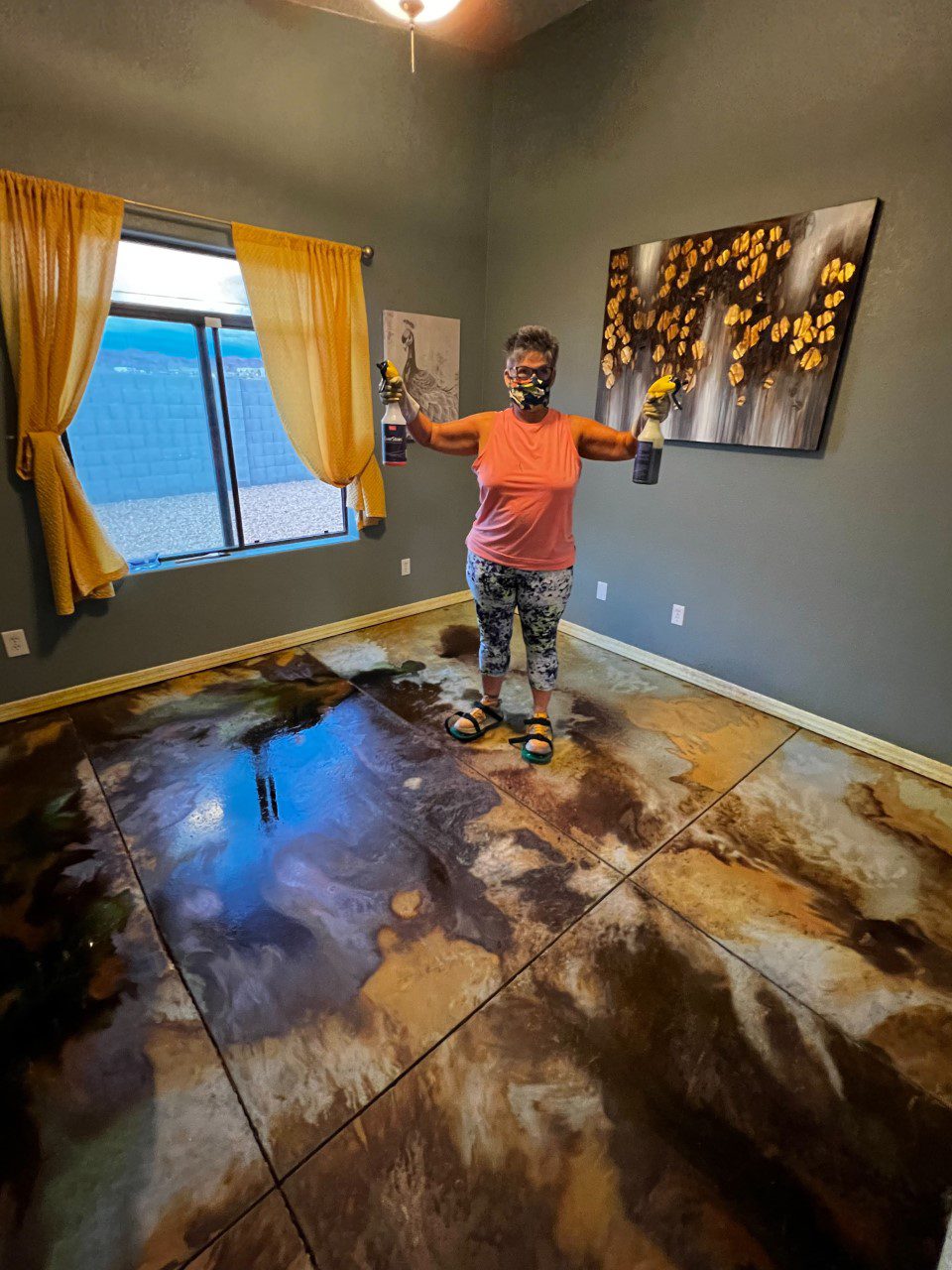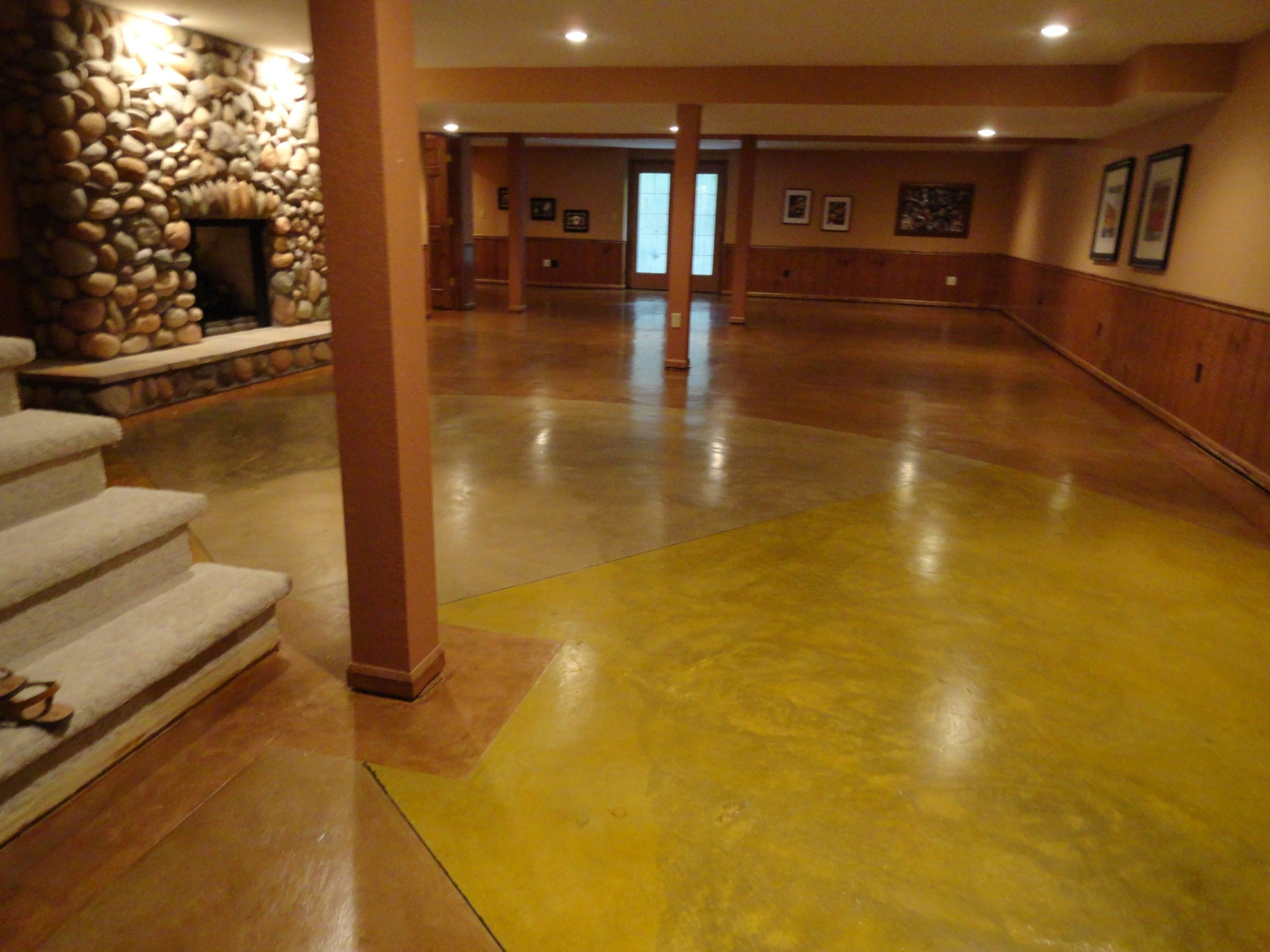Comprehending the Variety Of Solutions Offered in Floor Covering: Highlighting Stained Concrete Techniques
Stained concrete has actually emerged as a compelling floor covering alternative for various rooms. Its versatility lies in the selection between acid and water-based spots, each offering unique aesthetic appeals. Correct prep work and ongoing upkeep are necessary to assure its sturdiness and look. As the need for innovative floor covering remedies grows, understanding the subtleties of tarnished concrete strategies can open up brand-new possibilities for both residential and commercial atmospheres. What distinct benefits might this floor covering alternative offer a project?
The Basics of Stained Concrete
Stained concrete serves as a functional flooring choice that integrates resilience with visual charm. This flooring strategy entails using a specifically created stain to the concrete surface, which passes through and changes the color of the material. The procedure not just boosts the appearances of concrete yet also uses the benefit of safeguarding it from deterioration. Stained concrete can achieve a wide variety of looks, from earthy tones to vibrant shades, making it suitable for numerous style motifs.
Proper preparation of the concrete surface area is essential for ideal outcomes. This may consist of cleansing, grinding, or etching to ensure the stain adheres effectively. Additionally, the application procedure usually includes using tools such as sprayers or brushes to attain consistent coverage. After staining, a sealer is commonly used to improve longevity and keep the vibrancy of the color. Inevitably, tarnished concrete provides an appealing and long-lasting floor covering remedy for domestic and industrial areas alike.
Kinds of Stains: Acid vs. Water-Based

In contrast, water-based stains offer a broader variety of shades and are simpler to apply. They do not respond chemically with concrete however rather give a surface color - stained concrete austin. Water-based discolorations are reduced in unpredictable organic compounds (VOCs), making them extra ecologically pleasant and ideal for interior projects. While they might not give the very same deepness of shade as acid discolorations, their flexibility and simplicity of use make them appealing for different applications. Eventually, the option depends upon the job's demands, preferred looks, and area
Strategies for Staining Concrete
The strategies for tarnishing concrete differ significantly in between acid and water-based techniques. Acid staining includes a chemical response that produces distinct, variegated colors, while water-based stains offer a broader scheme and easier application. Recognizing these procedures is necessary for attaining the preferred aesthetic in concrete flooring.
Acid Staining Refine
Acid staining uses a vibrant method to enhance the aesthetic allure of concrete surface areas. This process involves applying a mix of water, hydrochloric acid, and pigments to the concrete, which reacts chemically to produce vibrant, transparent colors. The concrete surface needs to be completely cleaned and prepped to assure suitable bond. When applied, the acid stain passes through the concrete, developing distinct marbled effects as it responds with the lime in the concrete. After the preferred color develops, the surface is neutralized and washed to halt the response. A sealant is applied to shield the finish and boost sturdiness. Acid staining not just transforms the appearance of concrete however also supplies a lasting remedy for ornamental floor covering.
Water-Based Staining Advantages
How can water-based staining boost the visual and practical high qualities of concrete surface areas? Water-based discolorations provide a functional solution for improving concrete, giving vibrant shade alternatives while ensuring ecological safety and security. Unlike acid stains, water-based choices pass through the surface, permitting also color circulation and a range of finishes, from matte to glossy. In addition, they are reduced in unstable natural compounds (VOCs), making them much less harmful to indoor air quality. Their quick drying time promotes faster job completion, while their resistance to fading makes sure durable beauty. Water-based stains can additionally enhance the concrete's resilience and resistance to spots, making them an ideal selection for both household and commercial applications. Eventually, they offer a sustainable, appealing service for numerous concrete surface areas.
Style Possibilities With Stained Concrete
Stained concrete offers a variety of design possibilities that can boost any room. Methods such as shade variant, various surface finishing alternatives, and custom-made layout patterns enable unique and individualized floor covering remedies. These elements not only elevate appearances yet likewise contribute to the general performance of the concrete surface area.
Color Variant Methods
While exploring the design opportunities of stained concrete, color variant methods play a critical role in improving both aesthetic appeal and functionality. These strategies enable the production of special patterns and impacts that can transform a simple concrete surface area into an aesthetically striking aspect of a room. Choices such as acid staining, which responds chemically with the concrete, generate abundant, transparent colors that mimic natural rock. Water-based stains use a wider color palette and permit for more control in style. Layering different spots can produce depth and dimension, offering a personalized look. By incorporating color variation strategies, designers can attain diverse styles, from rustic to modern, guaranteeing that tarnished concrete fits perfectly right into any layout scheme.
Surface Finishing Options
The expedition of shade variation techniques establishes the phase for thinking about surface area finishing choices, which substantially impact the general appearance and capability of discolored concrete. Different coatings can enhance the aesthetic charm and durability of the surface. Usual options include matte, satin, and shiny coatings, each offering a distinct visual impact. Matte coatings provide a refined, understated sophistication, while satin finishes strike an equilibrium in between shine and practicality, making them prominent for residential and industrial rooms. Glossy surfaces, on the other hand, develop a high-shine appearance, enhancing color vibrancy and light representation. In addition, surface area therapies such as sprucing up or securing even more boost longevity, making these ending up choices essential factors to consider click for info in developing functional and visually appealing stained concrete floors.
Custom Layout Patterns
Just how can personalized layout patterns raise the appeal of discolored concrete? By integrating special styles, discolored concrete can transform normal floor covering into a striking visual statement. Customized patterns, such as geometric shapes, elaborate motifs, or organic designs, permit personalization, making spaces feel tailored and welcoming. Customers can select from a selection of strategies, including saw cuts, stencils, or overlays, to achieve wanted results. In addition, incorporating multiple colors with numerous stain methods enhances the deepness and dimension of the patterns. These layout opportunities not only boost aesthetic allure however also raise the worth of property or commercial rooms. Ultimately, custom style patterns provide a possibility for imagination, establishing discolored concrete apart from standard flooring alternatives.
Preparing Your Concrete Surface
Proper preparation of the concrete surface is important for accomplishing a successful tarnished surface. This procedure begins with complete cleansing to eliminate dust, oil, and any various other contaminants. A pressure washing machine or a flooring scrubber can efficiently eliminate these materials, guaranteeing a fresh start for staining. After cleansing, it is important to fix any kind of cracks or flaws in the concrete. This can be completed using a concrete patching compound, which must be permitted to cure completely prior to continuing.
As soon as the surface is clean and fixed, grinding or fining sand might be required to produce a smooth, also texture. This step boosts the concrete's ability to take in the stain consistently. Ultimately, a concrete etcher can be applied to open up the pores of the surface area, permitting far better adhesion of the stain (stained concrete austin). By following these preparation actions, the resulting tarnished concrete will display an extra vivid and lasting finish
Upkeep and Take Care Of Stained Concrete
Keeping tarnished concrete is essential for preserving its look and long life after the first preparation and application of stain. Normal cleansing is vital; sweeping or vacuuming to get rid of dust and debris stops scratches and dullness. For much deeper cleansing, a moderate pH-neutral detergent blended with water can be made use of, adhered to by thorough washing to prevent residue buildup.
Sealing stained concrete is an additional key maintenance step, as it secures the surface area from discolorations and moisture. Relying on the sealant type, reapplication might be needed every one to 3 years. Additionally, preventing rough chemicals and abrasive tools aids maintain the stability of the stain.
For outside stained concrete, it is suggested to clear snow or ice immediately to stop damage from freeze-thaw cycles. Overall, regular treatment guarantees that stained concrete preserves its vivid color and structural security with time, making it a durable flooring choice.

Cost Factors To Consider for Stained Concrete Floor Covering
When evaluating the expense of stained concrete flooring, potential property owners typically question the various factors that influence rates. Trick factors to consider include the size of the area to be covered, the intricacy check of the style, and the kind of stain utilized. Basic staining techniques often tend to be more budget friendly, while detailed patterns or numerous colors can significantly increase prices.

Geographic place is an additional factor, as costs can differ widely from one region to another. Recurring upkeep expenses ought to be factored in, as sealants and safety layers might be needed over time to protect the aesthetic and resilience of the stained concrete.
Often Asked Inquiries
Can Stained Concrete Be Applied Over Existing Floor Covering?
The question of whether stained concrete can be used over existing flooring is often asked. Usually, it is possible, supplied the underlying surface area is clean, stable, and ideal for proper attachment of the stained concrete.
The length of time Does the Staining Refine Take?
The staining procedure normally takes a few hours to a full day, relying on the size of the location and the intricacy of the design. Healing may need additional time before the surface area is fully functional.
Is Stained Concrete Suitable for Outdoor Usage?
Stained concrete is without a doubt suitable for outside use, as it endures different climate condition. Its resilience and visual allure make it a popular option for outdoor patios, sidewalks, and driveways, boosting both functionality and visual rate of interest.
Can I Modification the Shade of Stained Concrete Later On?
The capacity to transform the shade of stained concrete later depends on various aspects, consisting of the initial stain kind useful site and surface area prep work. Consulting a professional can offer support on possible options and outcomes for color change.
Exist Eco-Friendly Options for Stained Concrete?
The questions regarding eco-friendly options for stained concrete reveals an expanding passion in lasting building practices. Many companies currently supply low-VOC discolorations and eco pleasant sealants, making sure visual charm while lessening ecological influence.